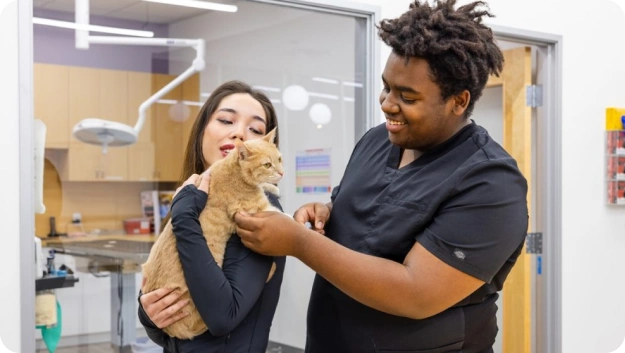Why Is My Cat Throwing Up White Foam?
There are several things that could be causing your cat to be throwing up white foam:
- Indigestion: Just like humans, cats can experience indigestion. When their stomachs are empty, they might vomit bile mixed with stomach secretions, which can appear as white foam.
- Hairballs: Cats groom themselves regularly, and during this process, they can ingest a lot of fur. This fur can form hairballs, which may cause them to vomit white foam.
- Gastrointestinal issues: Problems such as gastritis, inflammatory bowel disease, or other gastrointestinal disorders can cause a cat to throw up white foam.
- Dietary issues: Sudden changes in diet, or eating something that doesn’t agree with them, can lead to vomiting.
- Dehydration: If a cat is dehydrated, their stomach can produce more mucus, which might result in vomiting white foam.
- Toxins: Ingesting toxins or harmful substances can also lead to this symptom and requires immediate veterinary attention.
Home Remedies for Cat Vomiting
While it’s always best to consult with a veterinarian, there are some home remedies you can try if your cat is throwing up white foam:
- Ensure Hydration: Dehydration can exacerbate vomiting. Make sure your cat has access to fresh water at all times. If your cat is not drinking, you can try offering water with a bit of tuna juice or an electrolyte solution designed for pets.
- Diet Management: Provide small, frequent meals of bland food. Boiled chicken or a specially formulated diet for digestive issues may help soothe your cat’s stomach. Avoid feeding your cat fatty, spicy, or rich foods.
- Hairball Remedies: Regular grooming and specialized hairball prevention foods or treats can help reduce the risk of hairballs. Honnas Veterinary Practice Manager, Nick Folks, adds that wet food and increased water intake can help cats have an easier time digesting/moving their hairballs.
- Probiotics: Adding a pet-safe probiotic to your cat’s diet can help support their digestive health. We recommend Fortiflora as a great over the counter solution.
- Monitor Stress Levels: Cats are sensitive to changes in their environment. Try to keep their surroundings calm and consistent to minimize stress-related vomiting. Top tip: Did you know that cats are very sensitive to smell? So avoid cleaning products that are heavily scented to help keep them feeling good!
When to Contact Your Local Veterinarian
While home remedies can be helpful for minor cases, it’s essential to recognize when it’s time to seek professional help. Contact your local veterinarian in Austin, TX if:
- Persistent Vomiting: If your cat continues to vomit white foam for more than 24 hours, it’s time to call the vet. We would probably recommend bloodwork is carried out, and if you use us, this can be done in-house so that you get the results sooner.
- Severe Symptoms: If vomiting is accompanied by other symptoms such as lethargy, diarrhea, or changes in appetite, seek veterinary care immediately. Again, if you come to us at Honnas for an illness matter like this, we would carry out in-house lab work and/or send out fecal lab work, to get to the root of the problem and get your kitty back on track.
- Blood in Vomit: If you notice blood in your cat’s vomit, please contact us immediately.
- 4. Ingesting Toxins: If you suspect your cat has ingested a toxic substance, don’t wait, contact an emergency vet immediately. In addition to flushing out your cat’s system, lab work and, oftentimes, activated charcoal, to treat them, we will also reach out to poison control on your behalf.
- Dehydration: Signs of dehydration include dry gums, sunken eyes, and lethargy. If your cat shows any of these signs, they need immediate veterinary attention.
Summary
Seeing your cat throw up white foam can be worrisome, but understanding the possible causes and knowing how to treat it at home can help you manage the situation effectively.
Always keep an eye on your cat’s symptoms and behaviors, and don’t hesitate to reach out to your local veterinarian in Austin, TX if you have any concerns. Your vet is the best resource for ensuring your feline friend stays happy and healthy.
Remember, while home remedies can be helpful, they are not a substitute for professional veterinary advice. Always consult with your local veterinarian to ensure the best care for your cat.
If you’re in Austin, TX and your cat is experiencing persistent vomiting or severe symptoms, contact us right away to schedule an appointment.




